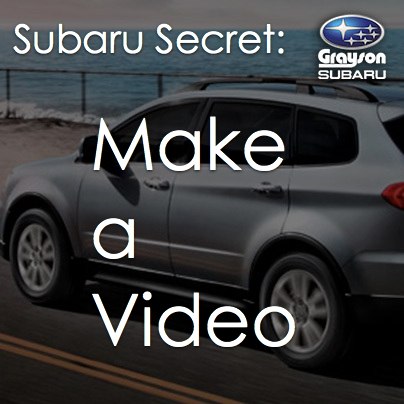Content Marketing Lessons From Subaru & Hyundai Campaigns
While attending a networking luncheon recently, several small business owners asked me, "Is social media really worth spending time and money on? Does the average small business really increase the bottom line by participating on Twitter and Facebook?" Three years ago, this question would have shocked me, but after serving several years as a strategist for digital media agencies, this concern is not only valid but common place among even the most innovative business owners.
As the content marketing strategist for iQuarius Media, I had the opportunity to work with an auto dealer from Tennessee that sold both the Subaru and Hyundai brands. The dealer came to us with a split perspective on social media and how best to utilize their resources. They embodied two frames of thought:
- A social media presence is imperative to "selling products and services" in the 21st century
- Social media doesn't work for "selling cars" and is a waste of resources
These perspective are both fundamentally wrong. If you look at social media as the ends instead of a means to an end, you forfeit the power of the medium. Social media should be used at all stages of the customer buying journey including building brand advocates after the point of purchase. Expecting to use social media for the sole purpose of selling cars would result in significantly skewed quarterly goals.
Our team started our partnership with the auto dealer by exploring social media case studies proving both the need for social media marketing and how best to approach the new age marketing practice. Then we had the opportunity to present a comprehensive content marketing strategy driven by the system I implemented at iQuarius Media. The content marketing system consisted of 7 cyclical stages:
- Plan - What are your goals? What are your customer personas? Do you have a well-articulated core story?
- Team - Does everyone know their role in the production of content pieces? Who is your director, editor, publisher, copywriter, graphic designer, etc?
- Ideas - What is your target audience talking about? What types of keywords are they using? Do you have a listening dashboard set up? Have you visited Q&A sites?
- Production - What does the work flow look like? Are there standard operating procedures in place? Do you use an editorial calendar to keep track of content production?
- Audience Development - Who are considered influencers to your target audience? Are all digital assets optimized for consumption, sharing and search engines? Have you considered paid advertisements to promote your content? Does your content appear everywhere in various formats?
- Conversions - Is your content guiding people closer to the point of purchase? Are your predetermined KPIs being reached consistently? Do you have a CRM that effectively tracks and converts opportunities to leads, leads to prospects, prospects to suspects, and suspects to clients?
- Measure & Optimize - How can you optimize your ideas and production? Is your community growing in quantity and relevance? How much traffic are your landing pages receiving and is that traffic converting into leads? How relevant are those leads?
Our primary objective was to produce valuable branded content through a series of videos that were repurposed into blog posts and word graphics. We set out to saturate our client's social networks with content aimed at increasing their brand awareness.
For their Subaru brand, we took some creative liberties with the corporate marketing campaign regarding "Love". According to our research, Subaru owners are extremely loyal and keep their Subarus for many years. So we developed an entertaining video series loosely based on a women's magazine article about how to keep the passion alive in your marriage.
Here are two commercials from the Subaru Secrets to Everlasting Love campaign (you might recognize the actor!):
 You can watch the rest of the videos on the auto dealers YouTube channel. After these videos were produced, we repurposed them into blog posts and even added a consolidated post once they were all published. You'll notice each post has a customized feature image that is considered a word graphic. These word graphics were developed primarily as a means to promote our video series throughout each social network. Besides videos, photos are the most consumed and shared content online.
You can watch the rest of the videos on the auto dealers YouTube channel. After these videos were produced, we repurposed them into blog posts and even added a consolidated post once they were all published. You'll notice each post has a customized feature image that is considered a word graphic. These word graphics were developed primarily as a means to promote our video series throughout each social network. Besides videos, photos are the most consumed and shared content online.
For their Hyundai brand, we took a more conservative route by producing an educational video series featuring gas saving tips. The overall content strategy remained the same as the one implemented for Subaru, which included the video series, blog posts and word graphics all disseminated via social media.
The Results
Due to our content marketing efforts, we managed to increase the dealer's footprint by an estimated average of 82% across each social network for both brands. The Subaru Secrets commercials did not receive as many views as the gas saving tips. This is likely because gas saving tips is a highly searched inquiry, according to Google's Keyword Tool. Nevertheless, we did expect to see viewership much higher than it was based merely on the brand loyalty found throughout the Subaru community. Overall, the results of the content strategy saw an increase in brand awareness meeting our primary objectives.
